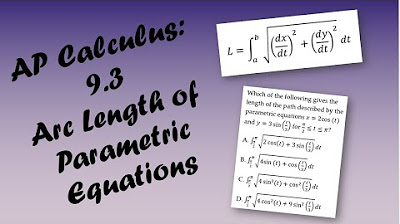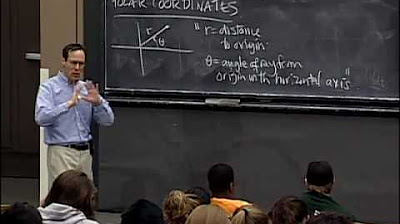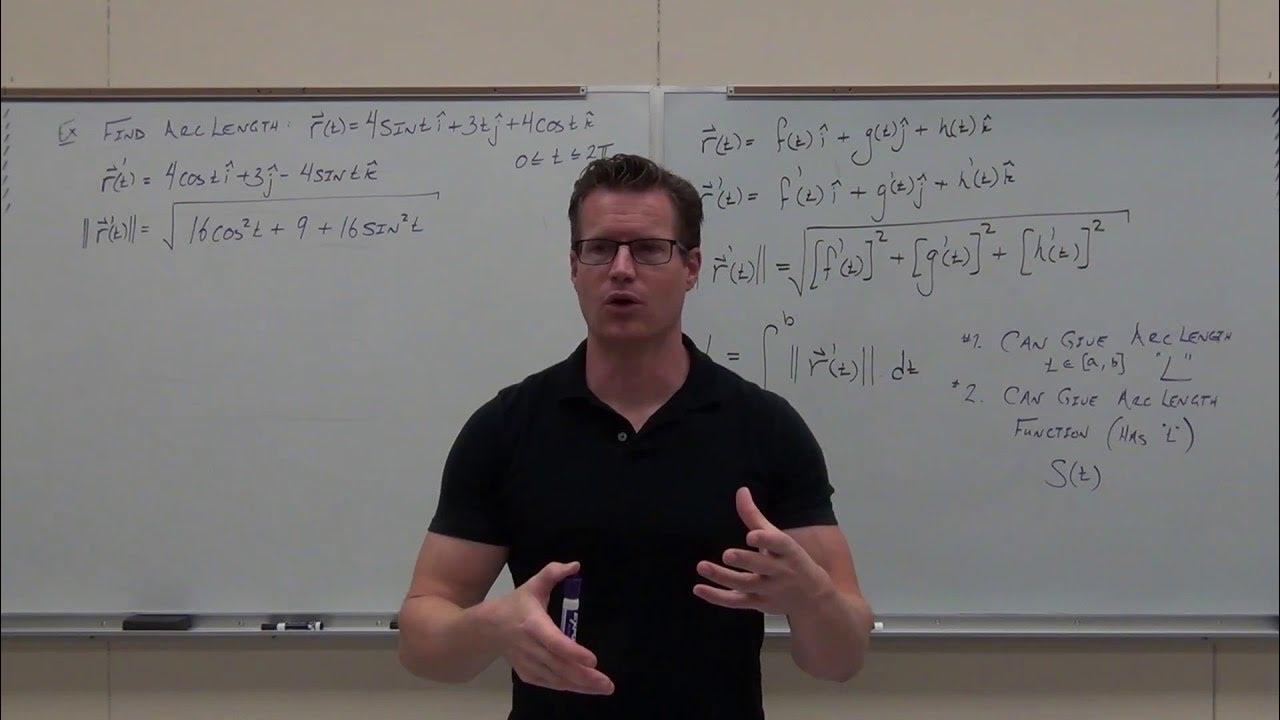Calculus Chapter 4 Lecture 35 Arclength 1
TLDRIn this calculus lecture, Professor Greist delves into the concept of arc length, starting with the fundamental formula and exploring its application to various types of curves. He explains how to determine the arc length element for both implicit curves and parametric curves, using the chain rule and differential analysis. The lecture includes examples such as calculating the length of a circle using parametric equations and a spiral, as well as the intriguing properties of the catenary curve and its physical implications. The professor also touches on the surprising infinite length of certain spirals and the concept of fractal curves, highlighting the complexities and fascinating aspects of one-dimensional curves.
Takeaways
- 📚 The lecture introduces the concept of arc length in calculus, focusing on one-dimensional curves.
- 📐 The formula for arc length is presented as the integral of the arc length element, emphasizing the importance of determining the length element.
- 📏 The arc length element is derived from a small infinitesimal piece of the curve, using the Pythagorean theorem for a right triangle with base \( \Delta x \) and height \( \Delta y \).
- 🔄 For an implicit curve, the arc length element involves the chain rule to express \( \Delta y \) as \( \frac{dy}{dx} \Delta x \), leading to the formula \( \sqrt{1 + \left(\frac{dy}{dx}\right)^2} \Delta x \).
- 🌐 In the case of a parametric curve, the arc length element is derived from the differentials \( \Delta x \) and \( \Delta y \) with respect to a parameter \( t \), resulting in \( \sqrt{\left(\frac{dx}{dt}\right)^2 + \left(\frac{dy}{dt}\right)^2} \Delta t \).
- 🔍 An example calculation of the arc length of a circle using parametric equations is provided, highlighting the simplification process.
- 📈 The script discusses the computation of arc length for an implicit curve defined by \( y = \log(\sin(x)) \), using the derivative of the function to find the arc length element.
- 🤔 The difficulty of evaluating integrals for arc length due to the presence of square roots is acknowledged, but the importance of integrals in solving arc length problems is emphasized.
- 🌉 The catenary, the shape of a hanging cable, is introduced as an example of a curve whose slope's rate of change is proportional to its arc length element, leading to a differential equation.
- 🔢 The solution to the catenary differential equation is explored, revealing that the shape of a hanging cable is a hyperbolic cosine function.
- 🌀 The concept of spirals is discussed, with an example of a spiral with a parametric representation, and the integral of its arc length element is considered.
- ∞ The surprising result that some spirals can have infinite length is presented, even though they may appear to be of finite extent.
Q & A
What is the main topic of Professor Greist's lecture 35?
-The main topic of lecture 35 is the concept of arc length in calculus, focusing on how to determine the arc length element for different types of curves.
How is the arc length of a curve defined in the context of this lecture?
-The arc length of a curve is defined as the integral of the arc length element, which represents a very small infinitesimal piece of the curve.
What is the formula for the arc length element when dealing with a curve in the plane?
-The arc length element for a curve in the plane is given by the square root of (dx squared plus dy squared), where dx and dy are the differentials of the x and y coordinates, respectively.
How does the chain rule apply to the arc length element when the curve is defined implicitly by y as a function of x?
-The chain rule allows us to express dy as dy/dx times dx, which when squared and manipulated algebraically, results in the arc length element being the square root of (1 plus (dy/dx) squared) times dx.
What is the arc length element for a parametric curve where x and y are functions of a parameter t?
-For a parametric curve, the arc length element is the square root of ((dx/dt) squared plus (dy/dt) squared) times dt.
Can you provide an example of calculating the arc length of a simple circle using parametric equations?
-Yes, the arc length of a circle with radius r can be calculated using the parametric equations x = r*cos(t) and y = r*sin(t), with the arc length element being r*dt. Integrating this from t=0 to t=2π gives the circumference of the circle, which is 2πr.
What is the equation for the catenary, which is the shape of a hanging cable?
-The catenary is described by the equation y = cosh(κx), where κ is a constant of proportionality related to the cable's tension and weight.
How does the length of a hanging cable relate to its slope?
-The rate of change of the slope of a hanging cable is proportional to its length element, which can be expressed as the derivative dy/dx being proportional to the square root of (1 plus (dy/dx) squared).
What is the result of the integral for the arc length of a spiral as T goes from 2π to infinity?
-The integral for the arc length of a spiral in this case diverges, indicating that the spiral has an infinite length as T approaches infinity.
How does the concept of a fractal curve relate to the idea of arc length?
-A fractal curve, such as the one created by repeatedly removing the middle third of a line segment and replacing it with two segments of 1/3 the original length, can have an infinite arc length despite being of a bounded extent.
What surprising result does the lecture mention regarding the relationship between the length of a chain and the width it spans?
-The lecture mentions that the length of a chain exhibits exponential growth given a linear growth in the width it spans, which is a surprising result derived from the integral of the arc length element for a catenary.
Outlines
📚 Introduction to Arc Length in Calculus
Professor Greist begins lecture 35 by transitioning from the complexities of infinite dimensional spaces to the fundamental concept of arc length, focusing on one-dimensional curves. He introduces the arc length element as an infinitesimal piece of a curve and explains its calculation through the Pythagorean theorem for a right triangle formed by differentials dx and dy. The lecture then delves into the practical application of this formula for both implicit curves, using the chain rule to express dy in terms of dx, and parametric curves, where x and y are functions of a parameter t. An example of calculating the arc length of a circle using parametric equations is provided, demonstrating the simplification process that leads to the well-known result of 2πr for the circumference of a circle.
🔍 Calculating Arc Length for Implicit and Parametric Curves
This section of the lecture continues the exploration of arc length by examining an implicit curve defined by the equation y = log(sin(x)). The professor demonstrates the process of finding the arc length element by differentiating the given function and simplifying the expression to obtain an integrable form of the arc length element in terms of dx. The integral of the cosecant function is then discussed, highlighting the complexity that can arise from the presence of a square root in the length element. The lecture also touches on the catenary, a curve formed by a hanging cable, and introduces a differential equation that describes its shape, leading to the solution of a hyperbolic cosine function for the catenary's equation.
🌐 The Catenary and Infinite Spirals
The professor discusses the catenary in more detail, explaining the physical principle that the rate of change of the slope of a hanging cable is proportional to its length element. This relationship is translated into a differential equation, which is then solved using a trigonometric substitution, leading to the hyperbolic cosine function. The length of the catenary is calculated by integrating the length element, revealing an exponential growth in length with respect to the linear growth of the cable's width. The lecture also presents an example of an infinite spiral, formed by a parametric representation with a 1/t coefficient, and explains the implications of the leading term in the length element causing a divergent integral, indicating an infinite length for the spiral.
🌀 Fractal Curves and Geometric Series in Arc Length
In the final part of the lecture, the professor explores the concept of fractal curves, starting with a simple line segment and iteratively replacing the middle third with two segments of one-third the length, effectively multiplying the total length by 4/3 at each step. This process results in a curve of infinite length within a bounded extent. The lecture also contrasts this with a spiral formed by squares, where the length is finite due to the geometric series involved. The professor emphasizes the surprising nature of one-dimensional curves and the importance of understanding the computation of the length element for future lessons on surface area.
Mindmap
Keywords
💡Arc Length
💡Infinitesimal Piece
💡Pythagorean Theorem
💡Chain Rule
💡Parametric Curve
💡Differentials
💡Integral
💡Hyperbolic Cosine
💡Fractal Curve
💡Geometric Series
💡Surface Area
Highlights
Professor Greist begins lecture 35 on arc length, transitioning from infinite dimensional spaces to one-dimensional curves.
Introduction to the concept of arc length as the integral of the arc length element.
Explanation of determining the arc length element using a small infinitesimal piece of the curve.
Derivation of the arc length element formula using the Pythagorean theorem for a right triangle with base DX and height DY.
Application of the chain rule to express dy in terms of dx for an implicit curve, leading to the arc length element formula.
Discussion on parametric curves and the derivation of the arc length element for such curves, involving functions of T.
Example calculation of the length of a circle using parametric equations with X and Y as functions of T.
Computation of the arc length for a circle, resulting in the well-known formula of 2πR.
Introduction of an example involving an implicit curve, y = log(sin(x)), and its arc length calculation from π/4 to π/2.
Derivation of the arc length element for the implicit curve using the derivative of log(sin(x)).
Integration of the arc length element for the implicit curve, leading to a final answer involving logarithmic and trigonometric functions.
Introduction of the catenary problem, the shape of a hanging cable, and its relation to a differential equation.
Solution of the differential equation for the catenary using a trigonometric substitution and separation of variables.
Derivation of the catenary curve's equation as a hyperbolic cosine function of x.
Calculation of the arc length for a catenary curve, demonstrating exponential growth in length with linear growth in width.
Discussion on the properties of spirals, their parametric representation, and the computation of their arc length.
Analysis of the surprising result of an infinite spiral's arc length, despite a bounded extent.
Introduction of fractal curves and their infinite length despite a bounded extent, using the example of a self-replicating curve.
Conclusion emphasizing the importance of understanding arc length computation for future lessons on surface area.
Transcripts
Browse More Related Video
5.0 / 5 (0 votes)
Thanks for rating:





